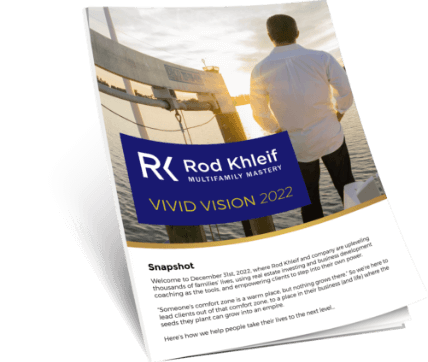On Finding the “Perfect” Deal
Leo Tolstoy once wrote, “If you look for perfection, you’ll never be content.” On one level, that might sound defeatist: “You’ll never be perfect, so why even try?” On the other hand, Tolstoy’ might just have offered a wise insight for real estate investment. read more
I’ve heard plenty of would-be investors go on about finding the “perfect” deal. Sometimes the word’s used as an excuse to rationalize poor decision-making: the “perfect” deal is whatever deal they happened to run across last week. Sometimes it stops people from taking any action whatsoever. Other times, it’s used to justify inaction: “I’ll never find the perfect deal, so I might as well stay home.”
Here’s what it all comes down to: there is no such thing as the “perfect” deal, only deals that more or less conform to your idea of a successful acquisition. Put simply, you get to decide what “perfect” means when it comes to buying real estate.
But, how do you do that?
Set Investment Criteria
Investment criteria are the parameters you’ll use to flesh out your idea of the “perfect” deal. Without investment criteria, you are shooting with a shotgun instead of a rifle. In this business you cannot be all things to all people. You must focus to be taken seriously by brokers, investors and lenders. In what follows, I’m going to walk you through some of the most important criteria you need to consider before you start looking for deals.
Keep in mind: In ways that will become clear as we go along, these categories all feed into one another. As you get to know your market, be prepared to fine tune as you go.
Market
Where do you plan to look for multifamily properties? It’s always best to focus on markets you know firsthand rather than those that seem interesting.
Here are four markets to consider first:
- Backyard –Looking for properties in a market in or near your current place of residence offers some significant advantages: firsthand knowledge of the real estate market, “insider” information on the best locations, ability to see properties in person, and hands-on management are just a few.
- Hometown – When it comes to analyzing a market, familiarity with the terrain is incredibly valuable. While you may be long removed from your hometown, you’ve probably held on to a strong intuitive sense of how the market and the area work. If you have family in the area, they can help you as well.
- Boots on the Ground – Speaking of family in the area, it’s a great idea to look for multifamily investment properties in markets where you have close, trusted friends and associates. With these representatives in place, you’ll have the local support you need to find and service properties in those areas.
- Retirement/Vacation Destination – If you already own a vacation home or are planning to spend your retirement in a particular location, then why not add that market to your list? You’ve already gotten acquainted with it through travel and or market research for your retirement/vacation home. Moreover, when the time does come to retire, you’ll have easy in-person access to your portfolio.
- If None of these Areas work – Draw a circle the equivalent of a 2 hour drive around your home and look there. You can easily find and manage property that close to your home.
Size
How many units are you looking for? For a newer investor, you may want to start with a smaller “residential” multifamily property (2-4 units) to help you learn the ropes. Residential multifamily is less threatening and the mistakes are smaller. Over time, however, you’ll find it difficult to scale your business with smaller properties. At that point, you can advance to larger commercial multifamily properties (5 plus units). You’ll find they are the same amount of work to purchase as the smaller residential multifamily properties.
Class
What type of property are you looking for?
- Class A – Premier and luxury properties fall into this category. They’re situated in prime locations and are usually among the newest properties in a market. You’ll pay a premium, but high rent, stable tenants, and low vacancy make Class A properties a worthwhile investment and the investment of choice for institutional investors. From a value perspective, these properties will normally appreciate at a high rate. Rental growth, on the other hand, can be slow and cash flow margins slim.
- Class B – Better suited to middle-income residents, these properties aren’t quite as new and exciting as their higher-end counterparts. They have some mid-level amenities, but nothing as posh as Class A. These properties may not be highly placed, but they do offer more opportunity for forced appreciation and rental growth. For that reason, the Class B market can be highly competitive.
- Class C – Properties are 30-50 years old and offer little (if anything) in way of amenities. They can be located in stable or declining areas. Those factors make Class C properties more affordable and easier to rent. The relative lack of stability in tenants, however, will make it harder to maintain high occupancy rates. The great advantage of these properties is that they offer plenty of opportunities for investors to improve the property and grow rental rates. (value add)
- Class D – As you could imagine, these properties lie at the low end of the spectrum. They’re often old, rundown, and located in the worst parts of town. The advantage of Class D properties is that they’re cheap and offer substantial cash flow. Managing tenants, however, can be incredibly time-consuming. Defaults will be common, turnover will be high, and you may end up spending more of your of time dealing with various management headaches than anything else. These properties are a cash flow play only.
Stability
Closely related to the type of property is its level of stability. On one end of the spectrum, you can purchase a relatively turn-key multifamily rental investment (stabilized). On the other end, you’ll find the proverbial clean slate (fully vacant).
- Stabilized – The property condition is solid, occupancy is reasonably high, and rental rates are in line with the market. So long as your numbers add up and cash flow is strong, there won’t be much for you to do to this property after closing.
- Value Add – Perhaps the property could use some updating, and rental rates could be bumped up to get them in line. This type will require more work and capital than a stabilized property, but the potential reward will be greater.
- Occupancy Less than 80% – Like the value add, this property will require more work from you than a stabilized property. At a relatively low rental rate, you’ll be taking on an additional risk which may also complicate your ability to secure funding. Nevertheless, with added risk comes added reward.
- Fully Vacant – Vacant properties are challenging in that you may have to go several months or longer with no income—forcing you to cover the mortgage bill yourself. Still, if you can buy a vacant property for the right price and renovate it to match current market standards, you’ll likely recoup those lost months and more in forced appreciation and increased rents. Important to know why it was vacant to begin with.
Price Range
Your price range will have to consider a number of factors: the market you’ve chosen, the types of properties you’d like to pursue, the size of those properties, and so on.
Of course, all of that depends on how much funding you can get your hands on. If you’re planning to secure a conventional loan on a residential multifamily property, speak with a lender as soon as possible to obtain pre-approval. If you’re going after larger properties, secure your equity funding and lending sources before/during your search.
Management Style
How involved do you want to be with your property?
- If you’re just getting started in your investment career and you’d like to handle all of the management yourself, then you may opt for a smaller-sized, higher-class property. If you try to self-manage a Class D property, you just might bounce yourself right out of the business. I have owned and managed D properties and I do not recommend them.
- If you’re planning to hire an on-site manager, this can be accomplished on just about any sized property. The larger properties will require a full time person with a salary, but even a property as small as a duplex can allow you to give one of the residents a small rent credit to keep an eye on things, pick up trash and show empty units.
- Working with a management company is prudent if you don’t have the time to deal with it, or you’re in full acquisition mode. If you listen to my podcast, you are likely aware that I am a proponent for self- management whenever possible and certainly once you have enough of an infrastructure to support it.
Conclusion
There are no “perfect” deals out there, but the more carefully you define your criteria, the more likely you’ll be to find the perfect deal for you.
These are the categories I’ve found to be the most important when setting out investment criteria. You may prioritize them in different ways or even add your own (you might care about aesthetics, for example).
What matters most is that you define your criteria as clearly as possible. Revisit them regularly to make sure they align with the realities of the market, your comfort level, and your goals. As you grow into this business, expect your criteria to grow with you.
Related quotes to consider:
[Follow Rod on Instagram for tons of great quotes]








